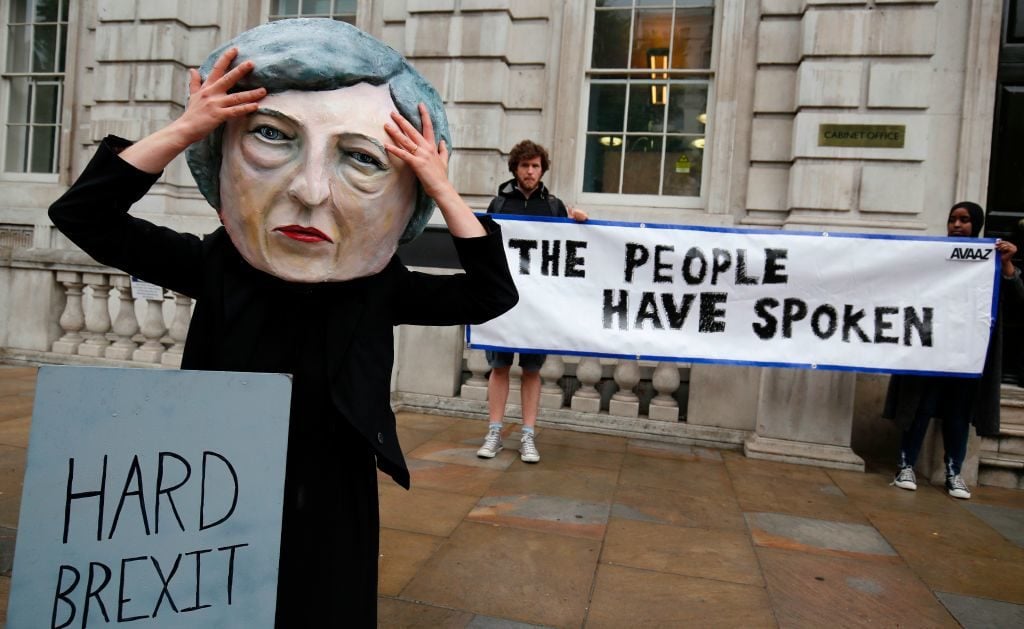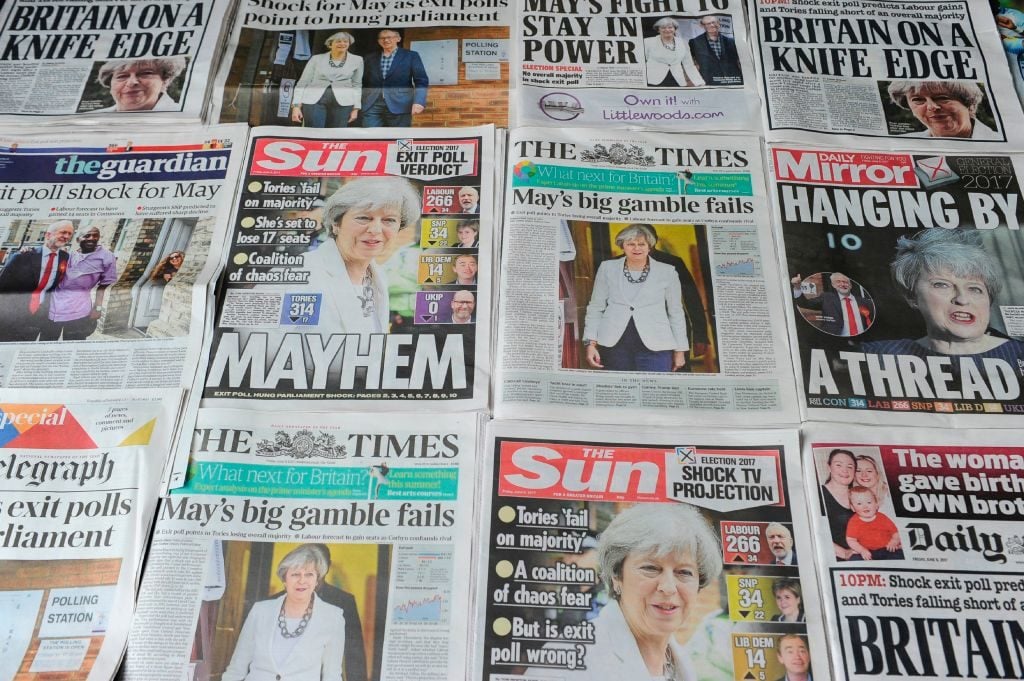Politics
What Does Theresa May’s Stunning Setback Mean for Culture? The Art World Weighs In
Artists Jeremy Deller, David Shrigley, and Grayson Perry swiftly responded to the election's unexpected results.

Artists Jeremy Deller, David Shrigley, and Grayson Perry swiftly responded to the election's unexpected results.

Lorena Muñoz-Alonso

Looks like the Labour party didn’t need Banksy after all.
UK’s election night on Thursday was a protracted and riveting affair that began with a proper bang shortly after 10pm, when the exit poll put Conservatives on 314 seats in Parliament (that is, down by 16 seats) and Labour on 266 (up by 36)—a sign of the unexpected developments to come.
A number of anti-Tory artists, like David Shrigley and Bob and Roberta Smith, swiftly took to social media in those first moments to express their outright joy—or veiled schadenfreude.
Even if it doesn't turn out as I would like it's still pleasing to think that the Tories will spend a few hours shitting themselves…
— David Shrigley (@davidshrigley) June 8, 2017
It's over for the Brexit pic.twitter.com/5RtvZxuSo2
— Bob&Roberta Smith (@BobandRoberta) June 8, 2017
Cornelia Parker, the official election artist, was also busy last night, posting images to her Instagram account @electionartist2017:
The final result of the UK’s general election—hung Parliament—came in the early hours of June 9, closely resembling those of the exit poll. In the end, the two main parties experienced remarkable changes, with the Tories getting 318 seats (down 12) and Labour, 261 (up a whopping 31). This means that Conservative Prime Minister Theresa May has lost her majority.
Artists React
“This is what happens when you run a repetitive, patronizing campaign based around a person with little imagination or charisma,” the artist Jeremy Deller told artnet News this morning. “Also young people got caught out last year with the [Brexit] referendum and Labour understood this.”
“[May] was not a convincing human being, let alone as a candidate,” added Deller, whose “Strong and stable my arse” poster, criticizing May’s campaign slogan, has become the defining artwork of this election.
A pact reached hastily this morning with the Democratic Unionist Party might still enable May to form a government, despite facing calls for her resignation ahead of the Brexit talks, which are due to start in just 10 days, Reuters reports.
At the palace hoping to get in first and form a govt while the others are dithering pic.twitter.com/bC5cLnzAoV
— Grayson Perry (@Alan_Measles) June 9, 2017
May is slated to visit the Queen at around 12:30pm today to confirm that a deal is in place and ask permission to form a government. Meanwhile, the artist Grayson Perry posted a photo to Twitter of himself at the doors of Buckingham Palace, with a humorous caption about seizing the moment to ask to form a government himself first.
May called for a snap election in mid-April, on the grounds of seeking “a stronger hand” in the dreaded Brexit negotiations with Brussels. With Labour Leader Jeremy Corbyn lagging behind in the polls, it seemed that May’s assumption of a landslide victory for her and her party wasn’t off the mark.
Thriving on adversity, however, Corbyn delivered an outstanding campaign, giving highly popular speeches at rallies attended by thousands of people and harnessing the youth vote. (Yesterday evening, a few hours before the polling stations were due to close, Shrigley posted a photo of a little Corbyn knitted dolly, encouraging people to vote for him. The artist has been very active on social media during this campaign.)
Let's get this guy elected! Still time to vote. pic.twitter.com/6r4kC6mFql
— David Shrigley (@davidshrigley) June 8, 2017
Meanwhile, May’s campaign was overshadowed by the two terrorist attacks in Manchester and London Bridge, which caused many to criticize her cuts to the Police force while she was Home Secretary, as well as by u-turns in several policies. Still, no one was seemingly prepared for Labour’s phenomenal rise, the biggest Labour voting swing since 1945, according to Fraser Nelson of The Spectator.
Jeremy Corbyn has just increased Labour's share of the vote more than any other leader in any other election since Attlee in 1945 pic.twitter.com/CwcHzHZ04q
— Fraser Nelson (@FraserNelson) June 9, 2017
What It Means for Art
It’s too early to understand what the implications of this election are for the art market, particularly since it’s not clear at this stage what form or shape the government will take. But it’s well known that markets do not like uncertainty and the election results have made the pound drop more than 2 percent and prompted a sharp divergence in UK equity, according to the Financial Times.

An arrangement of British daily newspapers are photographed as an illustration in London on June 9, 2017 showing front page stories about the exit poll results of the snap general election. Photo DANIEL SORABJI/AFP/Getty Images.
Labour has been much more explicit about arts policies in its campaign, launching a dedicated Culture manifesto that features significant proposals, including the creation of a £1-billion Cultural Capital Fund to invest in the UK’s cultural infrastructure, the creation of a cross-departmental cabinet committee in Parliament on the arts and creative industries, and the restoration of grants to aid funding of the Arts Council (which would offset the £42.8 million that has been cut from the Arts Council over the past six years of Tory leadership, according to Labour).
Meanwhile, the Conservatives opted for more general statements like, “We will continue our strong support for the arts, and ensure more of that support is based outside London.”
But two of the most relevant proposals to the art world made by Corbyn during the campaign are perhaps these: his pledge to guarantee the rights of EU citizens in the UK in the Brexit talks (which would reassure the thousands of European artists and art workers settled in the UK), and his plans to scrap tuition fees in universities across the country (which would make art schools affordable once again to all those who can’t spend thousands of pounds on each academic year).
Hung parliament pic.twitter.com/pyXSNCx7vn
— David Shrigley (@davidshrigley) June 9, 2017
As the country awaits a resolution on the hung parliament, one wonders what famously pro-Conservative artists like Tracey Emin might think of this situation. artnet News contacted White Cube gallery to gauge the thoughts of Emin and dealer Jay Jopling about the election results, but had not received a reply at the time of publishing.